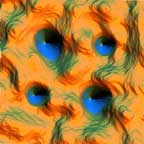NIST Looks
at Nanoscale Physics
Contact:
Michael Baum, (301)
975-2763
 |
| This particular
structure was made with a scanning tunneling microscope at a
very cold temperature of 2.3 Kelvin (about -455 degrees Fahrenheit).
The larger blue peaks (upper left and lower right) are a pair
of cobalt atoms, while the two smaller peaks are single cobalt
atoms. The swirls on the copper surface illustrate how the cobalt
and copper electrons interact with each other. |
This image of
cobalt atoms arranged on a copper surface represents one of the
first structures from the new Nanoscale
Physics Facility at the National Institute of Standards and
Technology. Informative as it is beautiful, this 8-nanometer-square
structure is helping scientists to better understand the physics
of ultratiny objects.
NIST physicists
designed and built the Nanoscale Physics Facility so they could
manipulate and arrange atoms, one by one, into desired patterns
on a metallic surface.
"One of
our motivations for doing this is to enable the U.S. electronics
industry to manufacture smaller, faster, and more powerful and versatile
communications devices and computers," says project leader
Joseph Stroscio.
In the not
too distant future, as electronic chip features shrink, they will
approach the boundary between classical and quantum laws of physics.
At the quantum level, single atoms and subatomic particles like
electrons or photons can behave in very unusual ways not predicted
by the classical laws of physics which govern larger objects.
In the Nanoscale
Physics Facility, NIST physicists are exploring the physical effects
of quantum phenomena in a new generation of nanoscale devices. By
building tiny structures atom by atom, NIST scientists are able
to see how the cloud of electrons orbiting each atom changes the
fundamental physical properties of the assembled structures.
This particular
structure was made with a scanning tunneling microscope at a very
cold temperature of 2.3 Kelvin (about -455 degrees Fahrenheit).
The larger blue peaks (upper left and lower right) are a pair of
cobalt atoms, while the two smaller peaks are single cobalt atoms.
The swirls on the copper surface illustrate how the cobalt and copper
electrons interact with each other.
This structure
and others like it allow scientists to compare experimental electron
energy level structure to theoretical models. The new Nanoscale
Physics Facility is located at NIST headquarters in Gaithersburg,
Md.
To learn more
about the NIST Nanoscale Physics Facility, see http://www.physics.nist.gov/Divisions/Div841/Gp3/Facilities/nano_phy.html.
|

